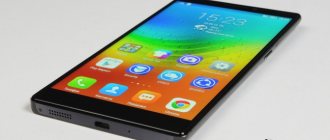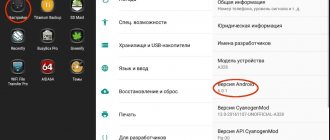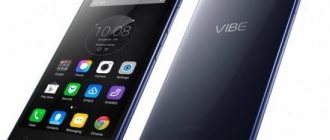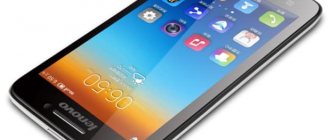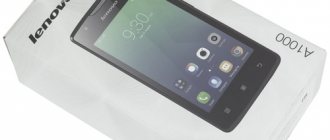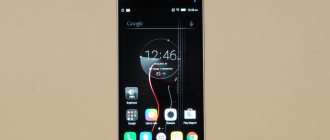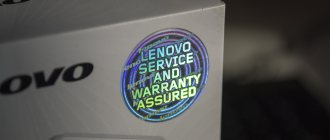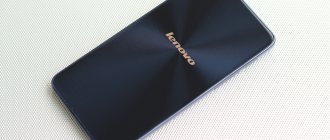All technical characteristics of the Lenovo A1000 smartphone and video review of the model. Smartphones from the Chinese company Lenovo are one of the market leaders. The company's main production is in the field of computers and laptops, however, many smartphone models meet customer expectations, representing an excellent balance between price and quality. Lenovo is a fairly young company, but during this time it has become one of the world's largest manufacturers of everything in the field of technology.
Lenovo A1000 Specifications
Lenovo's A-series has been around for quite some time. Here are smartphones aimed at the general consumer - everyone can find a phone they can afford: from the cheapest, like our A1000, to the “shovel-shaped” A7000 with a 5.5-inch screen and a price three times higher. However, the closest brother of the handset in question is the A2010, which also turned out to be a very good offer. So let’s compare them to figure out whether it’s worth paying an extra small amount and getting a more advanced device, or whether you can get by with the most basic model.
- Official Lenovo website.
- Instructions for Lenovo A1000.
- Firmware for Lenovo A1000.
Both smartphones are really similar to each other, although there are serious differences between them. So, the A2010 has a larger screen, which makes working with it more convenient, and a more modern processor, although the amount of memory is the same, as, we note, the battery capacity.
More specifically, the Lenovo A1000 has a Spreadtrum SC7731G processor. Inside it there are four not-so-modern Cortex-A7 cores operating at a frequency of 1.3 GHz. So it turns out that the budget smartphone is equipped with an outdated and not the fastest, but 4-core chipset. For its price this is a good option. Moreover, even Samsung does not disdain these “spreadrooms”, installing them in its “budget” products, which cost twice as much as our Lenovo (Samsung is a brand, of course).
Also inside the chip is an old Mali-400 MP2 video card, equipped with only a couple of execution pipelines. For 2012 this is an excellent solution, and in 2021 it is an ultra-budget solution. But don’t be upset - nothing will slow down on it. If only because the A1000 screen has a low resolution of 800x480 pixels, which means it does not need a powerful video core. The “ambush” here lies elsewhere - only OpenGL ES 2.0 is supported, while more and more games use OpenGL ES version 3.0 and even 3.1. For now they still maintain compatibility with the old version, but in the future they will abandon it.
Lenovo did not skimp on memory, for which special thanks go to it. We still remember with a shudder the Samsung Galaxy J1, released at the beginning of 2015 on a dual-core Spreadtrum processor, equipped with 512 MB of RAM and 4 GB of flash memory. In the A1000 you get 1 GB of RAM and 8 GB of flash memory, so a certain operating comfort is guaranteed.
Otherwise, the characteristics of a budget Chinese smartphone are typical. Connectivity is supported by Wi-Fi, including 802.11n, Bluetooth 4.0 and 3G connectivity. Don't expect any 4G here yet. And, if you look at it, why do you need fast Internet on a phone like this?
A brief comparative review of budget Lenovo smartphones: A1000 and A2010
Budget smartphones A1000 and A2010 from Lenovo are worthy representatives of their price segment. Dual-SIM models of 2015 differ from most other inexpensive devices by the presence of the new Android Lollipop system. In the AnTuTu benchmark, both devices scored more than 19,000 points thanks to the use of productive hardware - 4-core processors and fast video chips.
Lenovo A1000 and A2010: similarities 1. Design Lenovo's budget phones differ only in size, which is explained by the difference in display diagonal. The design of the models is identical: a laconic plastic monoblock, a convex removable lid, beveled side edges with rounded corners. The devices are available in two colors - black and white. 2. Screens Smartphones received cheap TFT displays with a modest resolution: Lenovo A1000 - 480x800 pixels, A2010 - 480x854 pixels. Buyers of the Foxtrot online store note that the screens have the classic disadvantages of TN matrices - low contrast levels and small viewing angles. These disadvantages are interrelated with the advantages - economical battery consumption and short response time (2-3 ms). 3. Memory New products of 2015 are equipped with a built-in memory of 8 GB, expandable with a Micro SD card up to 32 GB. System performance is ensured by 1024 MB of RAM. 4. Main camera 5-megapixel rear camera modules allow you to take clear and bright pictures in good lighting. The quality of color reproduction is at an average level due to the impossibility of manually adjusting the white balance. The cameras of the A1000 and A2010 models are equipped with an LED flash, but do not have an autofocus function. 5. Autonomy Batteries with a capacity of 2000 mAh hold a charge for two days when operating in energy-saving mode. With a more intense load, the Li-Po battery is discharged in 8-9 hours. Lenovo A1000 and A2010: differences 1. Hardware The older model A2010 has on board a powerful MediaTek MT6735M chipset, consisting of a processor with 4 Cortex-A53 cores (1 GHz) and a built-in Mali-T720 GPU. The MediaTek chipset supports the LTE module, unlike the 4-core Spreadtrum SC7731 chip (1.3 GHz), which ensures the performance of the A1000 smartphone. 2. Front cameras Selfie lovers should give preference to the A2010 model, equipped with a 2-megapixel additional module. The photographic capabilities of the younger device are limited by the low resolution of the 0.3 megapixel selfie camera. 3. Display diagonal The compact A1000 smartphone has a 4-inch display with a higher pixel density of 233 ppi due to its smaller width. The display of the A2010 model has a 4.5-inch diagonal and a lower dot density of 218 ppi.
Performance testing
Now let's see who will be faster - Lenovo A1000 or A2010. More precisely, it’s already clear who it is, but what’s interesting is the size of the separation of the second smartphone.
The old and simple system-wide test Smartbench 2012 shows parity (!) in the computing power of two smartphones. Inside the A2010, we recall, a 1-GHz MediaTek MT6735 is installed - a new-generation budget chipset equipped with four 64-bit Cortex-A53 cores. Obviously, on not the most complex tasks, the architectural superiority is offset by the higher frequency of the opponent. However, the graphics performance is higher on the Mali-T720 MP2 video card, which is equipped with a MediaTek processor. By the way, it supports OpenGL ES 3.0.
The modern Antutu test also shows the parity of both phones. It turns out that the difference between the A1000 and A2010 will not be visible to the eye. We must assume that it will appear in highly loaded applications, but in most cases it does not.
But in another old Quadrant system-wide test, our Lenovo A1000 was left behind and it shows. If we analyze the result in more detail, then in terms of “pure” computing power, both smartphones are approximately the same, but in the field of working with RAM and 2D/3D graphics, the A2010 clearly takes the lead.
The SunSpider test, which measures the speed of JavaScript in the browser, gave the victory to the A2010 (here, the lower the result, the better). So Internet surfing will be more comfortable on an “older” phone. Including thanks to its larger diagonal screen.
In the old 3D tests, the A1000 was ahead of something. But here we will attribute its “victory” to the crude firmware in the A2010 - when we had this smartphone, there was a preliminary non-final assembly of the system.
Moreover, the modern and complex 3DRating benchmark gave victory to the A2010, even if its superiority is not so great.
In terms of autonomy, according to our methodology, the Lenovo A1000 performed better. This is understandable - both devices have the same 2000 mAh battery, but the A2010 has a faster processor and a larger screen, which affects power consumption. Generally speaking, the autonomy of the A1000 can be assessed as average - you can safely count on a day and a half of use in “moderate” mode.
The maximum energy consumption was expected in 3D graphics. The battery is also drained when the screen is on, which can be seen in other tasks: reading, video, 2D games and surfing the Internet.
Since the Lenovo A1000 is not a smartphone from a "no-name small manufacturer", there are certain features to ensure energy savings, albeit very few of them. In particular, it is possible to add applications to exceptions that will not be limited in resource consumption.
On the larger side, Lenovo A1000 satisfied us in terms of performance and autonomy. For its price, it works well, the interface as a whole does not slow down (not in the camera application), and I was pleased with the battery life.
Lenovo A1000 Specifications
| Weight | 132 g |
| Design | |
| SIM card type | |
| Dimensions (WxHxD) | |
| Number of SIM cards | |
| Type | smartphone |
| Type of shell | |
| OS version | |
| Multi-SIM mode | |
| Housing material | |
| Control | |
| Pixels per inch (PPI) | |
| Automatic screen rotation | |
| Screen type | |
| Touch screen type | |
| Image Size | |
| Diagonal | |
| Recording videos | |
| Front-camera | |
| Rear camera | |
| Headphone jack | |
| Rear camera functions | |
| Photoflash | |
| Audio | MP3 |
| Satellite navigation | GPS |
| Standard | GSM 900/1800/1900, 3G |
| A-GPS system | |
| Interfaces | Wi-Fi, Bluetooth, USB |
| Built-in memory capacity | |
| Memory card slot | Yes, up to 32 GB |
| CPU | Spreadtrum SC7731, 1300 MHz |
| Video processor | Mali-400 MP2 |
| Number of processor cores | 4 |
| RAM capacity | |
| Battery type | |
| Talk time | |
| Charging connector type | |
| Standby time | |
| Battery capacity | 2050 mAh |
| Battery | |
| Flashlight | |
| Sensors | |
| Airplane mode | There is |
| Max. video resolution | |
| Camera | 5 million pixels, LED flash |
| Camera functions | |
| LTE bands support | |
| Announcement date | |
| Diaphragm | |
| Dual camera | |
| Fast charging function | |
| Speakerphone (built-in speaker) | There is |
| Peculiarities | |
| Equipment | |
| Platform | |
| operating system | |
| CPU frequency | |
| Memory card slot | |
| Memory card type | |
| Year of market entry | |
| Dimensions (HxWxT) | |
| Fingerprint scanner | |
| Shockproof housing | |
| Water protection | |
| Number of screen colors | |
| Touch screen | |
| Permission | |
| Screen diagonal | |
| Multitouch | |
| Color screen | |
| Automatic screen rotation (accelerometer) | |
| Pixels per inch | |
| Proximity sensor | |
| Barometer | |
| Light sensor | |
| Number of megapixels of the front camera | |
| Flash type | |
| Built-in flash | |
| Number of megapixels | |
| Autofocus | |
| Geo-tagging | |
| USB | |
| WiFi | |
| Bluetooth standard | |
| Headphone output | |
| Infrared port (IRDA) | |
| Bluetooth | |
| MHL support | |
| NFC | |
| EDGE | |
| GPRS | |
| HTML | |
| GLONASS | |
| A-GPS | |
| BeiDou | |
| GPS module | |
| FM radio | |
| Stereo speakers | |
| Dictaphone | |
| MP3 player | |
| Speakerphone | |
| Vibration alert | |
| MP3 ringtones | |
| Dictionary input | |
| Alarm | |
| Calculator | |
| Organizer/calendar | |
| Wireless charging function | |
| OS | Android 5.0 |
| Case type | classical |
| SIM card type | |
| Supported number of SIM cards | 2 |
| Dimensions | 64×124.5×10.6 mm |
| Screen display type | color, touch |
| Screen size | 4 inch |
| Camera | autofocus |
| Video recording support | There is |
| Built-in memory | 8 GB |
| RAM | 1 GB |
| Talk time | |
| Waiting time | |
| Image format | 800×480 |
| Pixels per inch | |
| Light notifications | |
| Push-To-Talk | |
| Available memory | |
| Announcement date | |
| Sales start date | |
| Body material | |
| Control type | voice dialing, voice control |
| Working with multiple SIM cards | alternating |
| Touch screen type | multi-touch, capacitive |
| Rotate the screen | |
| Recognition | |
| Video resolution | |
| Video frame rate | |
| Geo Tagging | |
| Front camera | yes, 0.3 million pixels. |
| LTE support | |
| Max. memory card capacity | |
| Gyroscope | |
| Optical stabilization | |
| USB-host/OTG | |
| A2DP | |
| POP/SMTP client | |
| HSDPA | |
| HSUPA | |
| IMAP4 | |
| Compass | |
| Battery mount | |
| Touch Force recording | |
| Curved screen | |
| DLNA | |
| EMS | |
| Headphone input | |
| Charging input | |
| Built-in flashlight | |
| HSPA+ | |
| Scratch-resistant glass | |
| DC-HSDPA | |
| HSCSD | |
| USB-host | |
| Color: | |
| Protective glass | |
| Combined slot for SIM card and memory card | |
| Video resolution | |
| A2DP profile | |
| Navigation key | |
| Video Frame Rate | |
| Wi-Fi Direct | |
| FM transmitter | |
| Built-in radio antenna | |
| Sound timer | |
| Exchange between phone books | |
| Light indication of events | |
| Voice dialing | |
| USB charging | |
| Use as a flash drive | |
| Use as a USB storage device | |
| QWERTY keyboard | |
| SAR level | |
| Curved display | |
| ANT+ | |
| Face recognition | |
| WAV | |
| WMA | |
| A.A.C. | |
| DLNA support |
